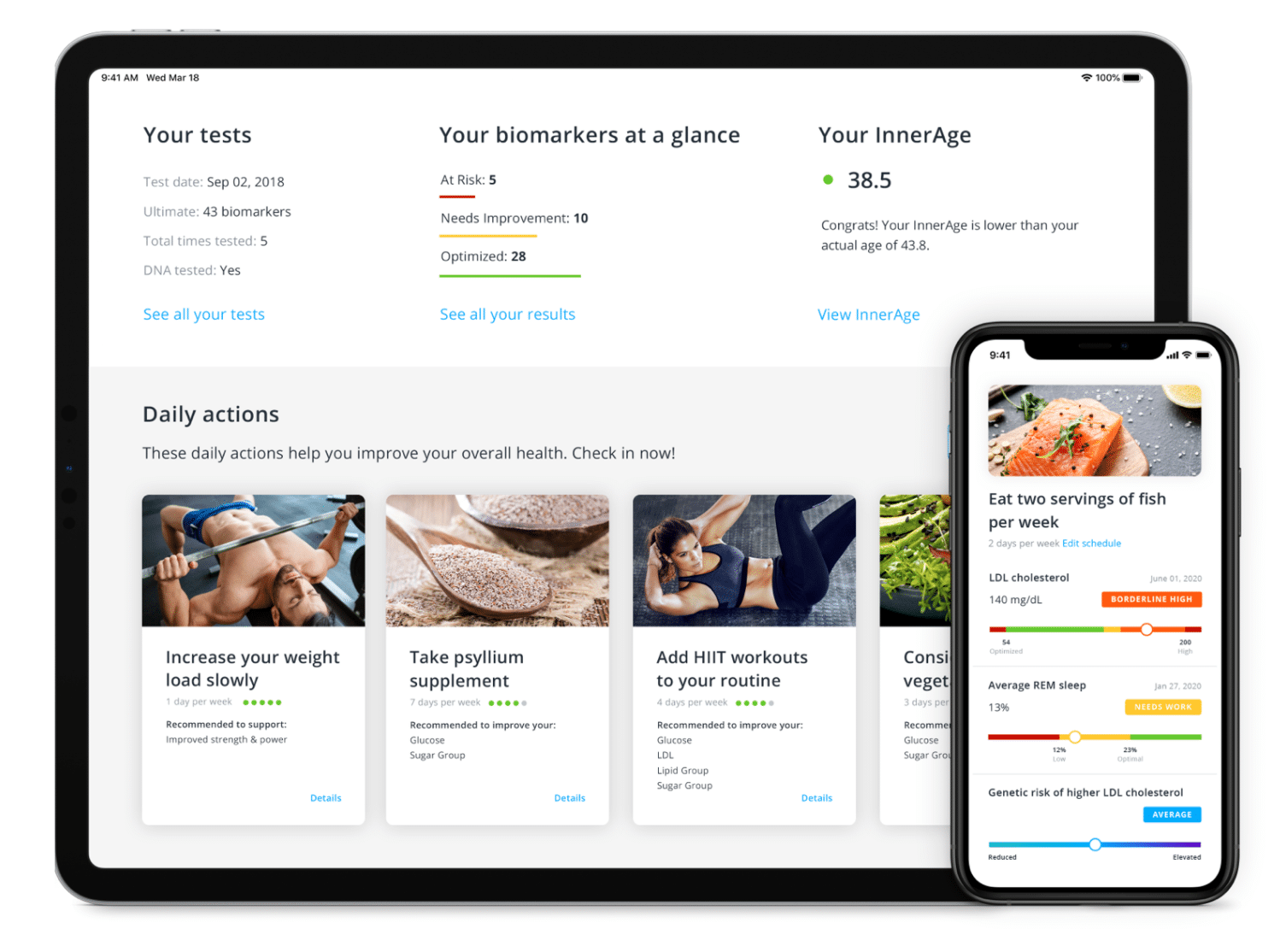It is my intention to help my body be the best it can at the age I am. This has led me to read and learn quite a bit about food, exercise, the effects of sleep, breathwork and meditation, and all manner of other modalities. This is all extremely interesting and, if not practical, it makes me an intriguing dinner guest. The problem with all this knowledge is that it is not specific to me — it is generalized as to how it is effective to all humans. Some things are common sense. Getting good sleep would seem to reduce my stress level, but what are my actual cortisol levels and how do they interact with my glucose levels? The best I can do is trial and error of what seems to feel right to me. As a wise man once told me, feelings are not facts.
What I need is a personalized and comprehensive set of measurements that will result in actionable recommendations that have a measurable impact on how well I am aging. I want the trackable data on how well I am doing and what precisely I can change to do better.
InsideTracker is one solution. It is a unique product combining a blood test, DNA test, lifestyle habits, and inputs from wearables such as Fitbit. All of this vast data is fed into a tremendously powerful algorithm that is based not on the general population but on the healthier population of people in the InsideTracker cohort. The result is a personalized and science-backed action plan that guides you to optimal health. They also offer a feature called InnerAge, which is the score of your biological age, the rate at which you are aging. This can then be compared to one’s chronological age as a ratio of how well you are aging. I may be feeling spry, but what does that data say?
Biological Age Plus Lifestyle Recommendations
What sets this test apart is: not only are you getting an accurate reading of what your biological age is, you are also receiving ultra-personalized science-based nutrition and lifestyle recommendations to improve it. This is a huge advantage over other tests. It is all fine to know a biological age metric, but what does it mean if there are no actionable suggestions attached to it? It is probably somewhat useful to only know if your biological age is much higher than expected; that would absolutely get attention. But isn’t it much better to know what exactly you could do to impact the number?

With re-testing at regular intervals, I can map the trajectory of my aging. Now I can have testing, behavioral modifications, and have the ability to graphically see how these are affecting my body over time. This seems to me to be an extremely useful tool, as compared to the lipid panel and other standard tests I get at my yearly physical.
“You have to optimize, constantly calibrate and tune your body”
Dr Gil Blander, PhD, founder and Chief Scientific Officer of InsideTracker, puts it this way: “The human body is the most complex machine in existence. I like to use the analogy of a car. When you bring your car in for routine maintenance, it gets hooked up to a computer for diagnostics, the problems are identified, fixed, hopefully giving your car another 50,000 miles and a new lease on life. We have to take that same approach with our bodies. You have to optimize, constantly calibrate and tune your body. You need to do this in order to reach your potential. We are driving blind, basically. And in order to open your eyes, you need to understand what’s happening inside your body. It depends on the individual and their goals; some biomarkers need more time than others to see variable changes. Once in every three to 12 months should be sufficient.”
The InsideTracker platform is based on 43 blood markers, and they have investigated hundreds. Their recommendations are based on a whopping 1.68 million data points of total blood markers tested. This is the sort of testing and recommendations that is only possible with tremendously powerful computational capabilities and is way outside the capabilities of what most of us are getting in our yearly physicals. Has your doctor ever asked to see you for your genomic testing to compare it to your blood work? Maybe not. My doc is doing his best to make an educated recommendation based on what is considered normal within the overall population. This is better than nothing, but we can now do better.
When Gil Blander, an expert in longevity and biometric data, founded the company in 2009, he thought to himself: We can do better to optimize people’s health. Working alongside some of the world leaders in aging research, such as MIT biologist Dr. Leonard Guarente and Harvard geneticist Dr. David Sinclair, the idea for an automated, algorithm-based personalized nutrition and lifestyle platform was born and refined. This is peer reviewed technology whose analysis and recommendations have only become more refined and targeted as the science has continued to advance.
“I decided to dedicate my life, personally, academically, and professionally, to helping people live longer and better lives”
Dr. Blander’s interest in creating InsideTracker is a personal one: “I lost a relative at a young age and in reflecting on that loss, I asked myself a fairly deep and compelling question: Why can’t we live forever? I decided to dedicate my life, personally, academically, and professionally, to helping people live longer, better lives. I was fortunate enough to assemble an unparalleled team of experts and thought leaders in personalized health and nutrition in order to help me reach this goal.”
The company recently released InnerAge 2.0, which is the test I am taking, with three times the biomarkers. The more useful biomarkers, the more personalized and accurate the resulting recommendations. The key here is discerning which biomarkers are useful and actionable out of the thousands that could be used. Just because something can be measured doesn’t mean it is useful.
Dr. Blander told me InnerAge has yielded some surprising findings. “The correlation between LDL and InnerAge for both females and males: We see cases when high LDL values contribute up to 10 years to a user’s age, making them biologically ‘older.’ At the same time, there are users with very healthy, low LDL and it makes them up to 7 years ‘younger.’ LDL is a very actionable biomarker, so it leaves a lot of room for improvement. We provide LDL insights and also actions to improve it which can lower your InnerAge. It is also important to note that your InnerAge changes, so people who test more often have much more visibility, control and insights on how to optimize their InnerAge.”
To have not only a long lifespan but also a long healthspan, we need to intentionally optimize the parts of our lives we have control over
I am of course interested in lifespan, but I am also very interested in healthspan. The average American lifespan has reached 79 — my target is 96 and climbing. Healthspan is the length of time that we are not only alive but functioning healthily. I would like my healthspan to overlay my lifespan as much as possible. To have not only a long lifespan but also a long healthspan, we need to intentionally optimize the parts of our lives we have control over. These include what we are eating, how we are exercising, and how well we are sleeping. There is much in life we can’t control, but I believe that the vast majority of factors that influence our life and healthspan are actually within our control. Having data that spells out which ones to focus our attention on would simplify things considerably.
I’m taking InsideTracker’s full suite of tests, the Ultimate, with blood testing, DNA and Fitbit connectivity through their new iOS mobile app, and also testing for my InnerAge. I’ll be sharing the test results here as soon as they arrive. Who knows what I’ll discover?
For AGEIST readers only, enter your promo code for 25% OFF storewide from InsideTracker here.
And get ready to optimize your body from the inside out.




This is so interesting. I love my Fitbit and can’t wait to check out InsideTracker to see how it integrates with it.
Please tell me this is not limited to the USA.